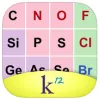Take a look inside 5 images
K-12 Periodic Table
Pros: Flexible color-coding, temperature settings, and intuitive interface make this a pretty helpful spot to study the elements.
Cons: Lacks explanations of simple terminology and even a simple quiz function.
Bottom Line: It's not super fun, but it's a great place to solidify study of the periodic table.
Project a tablet version in front of your class to give kids a nice visual understanding of how the table is organized. The tablet version would likely serve students in small-group situations best, while the phone version (with its teeny text but three layers of display) would be best suited for individual quiz and homework settings. You'll have to look elsewhere if you want formal quizzes with scores and progress tracking, however.
K12 Periodic Table is a periodic table reference app for high school chemistry and middle school science classes available for Android, iOS, and Kindle -- including tablet versions -- published by for-profit curriculum developer and provider K12. Tap on elements within the table to view mass, orbitals, Lewis dots, ionization, and more. Settings allow you to color-code various properties and change temperature scale to Kelvin, Celsius, or Fahrenheit. Phone device versions display each element at three levels of detail: The first level shows the table with symbols only; the second appears after a tap with symbol, atomic number, and mass; and the third shows additional properties like electronegativity and boiling point with an additional tap. While the tablet versions lack the second display level, they do allow users the ability to display in expanded format (which sacrifices easily recognizable size to accurate format).
While the fun factor is a bit low, K12 Periodic Table is easy to access and provides helpful features like color coding for classifications, most properties, representational icons using different size balls for radius length, and Lewis dot diagrams. Although it doesn't have a structured quiz function or explanations of basic terminology, you could use the three layers of display in the phone device versions for self-quizzing and memorization. It's a pretty convenient way to reference the periodic table, and while there isn't a ton of depth, you can definitely get quick, meaningful representations of elemental properties.











